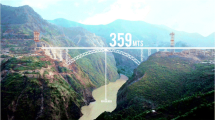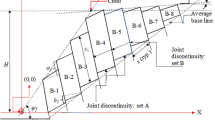Abstract
The shear stress response and rock mass deformation are significantly influenced by rock discontinuities. The rock mass becomes more distorted and loses strength as a result of these discontinuities. The orientations of these discontinuities determine the failure pattern of rock mass. These discontinuities can be unfilled or infilled. The shear behaviour of rock mass is largely affected if infill material is present there. The presence of infill material affects the shear behaviour of rock mass. In this paper, a rock slope inclined at an angle of 60°, with a single discontinuity of thickness 1.0 m inclined at an angle varying between 35° and 52° containing a weak soil as infill material is subjected to pseudo-static earthquake load. The horizontal coefficient of the earthquake is taken as 0.1 g. The factor of safety is obtained for each joint inclination. Numerical simulation is performed using FLAC2D and an analytical run is also performed using MATLAB, where reliability analysis using Monte Carlo simulation is carried out by considering uncertainties in rock properties.









Similar content being viewed by others
Data Availability
The datasets generated during and/or analysed during the current study are available with the authors.
References
Ausilio E, Conte E, Dente G (2000) Seismic stability analysis of reinforced slopes. Soil Dyn Earthq Eng 19(3):159–172
Bar N, Barton NR (2016) Empirical slope design for hard and soft rocks using Q-slope. In: ARMA US Rock Mechanics/Geomechanics Symposium (pp ARMA-2016). ARMA
Beyabanaki SAR (2020) A comparison between using finite difference and limit equilibrium methods for landslide analysis of slopes containing a weak layer. Am J Eng Res 9(12):68–79
Chen Z, Du J, Yan J, Sun P, Li K, Li Y (2019) Point estimation method: Validation, efficiency improvement, and application to embankment slope stability reliability analysis. Eng Geol 263:105232
Düzgün HŞB, Paşamehmetoğlu AG, Yücemen MS (1995) Plane failure analysis of rock slopes: a reliability approach. Int J Surface Min Reclam 9(1):1–6
Duzgun HSB, Yucemen MS, Karpuz CELAL (2002) A probabilistic model for the assessment of uncertainties in the shear strength of rock discontinuities. Int J Rock Mech Min Sci 39(6):743–754
Einstein HH, Veneziano D, Baecher GB, O’reilly KJ (1983) The effect of discontinuity persistence on rock slope stability. Int J Rock Mechan Min Sci Geomechan Abstr 20(5):227–236
El-Ramly H, Morgenstern NR, Cruden DM (2002) Probabilistic slope stability analysis for practice. Can Geotech J 39(3):665–683
Hoek E (1998) Factor of safety and probability of failure(Chapter 8). Course notes, Internet edition, http://www.rockeng.utoronto.ca/hoekcorner.htm
Hoek E, Bray JW (1981) Rock slope engineering. Institute of Mining and Metallurgy, London
Jimenez-Rodriguez R, Sitar N, Chacón J (2006) System reliability approach to rock slope stability. Int J Rock Mech Min Sci 43(6):847–859
Kanungo DP, Pain A, Sharma S (2013) Finite element modeling approach to assess the stability of debris and rock slopes: a case study from the Indian Himalayas. Nat Hazards 69:1–24
Kliche CA (1999) Rock slope stability. Society for Mining, Metallurgy, and Exploration, Inc
Kumar S, Tiwari G, Parameswaran V, Das A (2022) Rate-dependent mechanical behavior of jointed rock with an impersistent joint under different infill conditions. J Rock Mechan Geotechn Eng 14(5):1380–1393
Kumsar H, Aydan Ö, Ulusay R (2000) Dynamic and static stability assessment of rock slopes against wedge failures. Rock Mech Rock Eng 33:31–51
Latha GM, Garaga A (2010) Seismic stability analysis of a Himalayan rock slope. Rock Mech Rock Eng 43:831–843
Leshchinsky D, San KC (1994) Pseudostatic seismic stability of slopes: design charts. J Geotechn Eng 120(9):1514–1532
Li AJ, Cassidy MJ, Wang Y, Merifield RS, Lyamin AV (2012) Parametric Monte Carlo studies of rock slopes based on the Hoek-Brown failure criterion. Comput Geotech 45:11–18
Li AJ, Merifield RS, Lyamin AV (2008) Stability charts for rock slopes based on the Hoek-Brown failure criterion. Int J Rock Mech Min Sci 45(5):689–700
Ling HI, Cheng AHD (1997) Rock sliding induced by seismic force. Int J Rock Mech Min Sci 34(6):1021–1029
Liu X, Li DQ, Cao ZJ, Wang Y (2020) Adaptive Monte Carlo simulation method for system reliability analysis of slope stability based on limit equilibrium methods. Eng Geol 264:105384
Liu Y, Li H, Xiao K, Li J, Xia X, Liu B (2014) Seismic stability analysis of a layered rock slope. Comput Geotech 55:474–481
Macedo J, Candia G (2020) Performance-based assessment of the seismic pseudo-static coefficient used in slope stability analysis. Soil Dyn Earthq Eng 133:106109
Michalowski RL, Park D (2020) Stability assessment of slopes in rock governed by the Hoek-Brown strength criterion. Int J Rock Mech Min Sci 127:104217
Nawari O, Hartmann R, Lackner R (1997) Stability analysis of rock slopes with the direct sliding blocks method. Int J Rock Mech Min Sci 34(3–4):220-e1
Obregon C, Mitri H (2019) Probabilistic approach for open pit bench slope stability analysis–a mine case study. Int J Min Sci Technol 29(4):629–640
Park HJ, West TR, Woo I (2005) Probabilistic analysis of rock slope stability and random properties of discontinuity parameters, Interstate Highway 40, Western North Carolina, USA. Eng Geol 79(3–4):230–250
Ray A, Rai R, Singh TN (2022) The effect of discontinuity orientation and thickness of the weathered layer on the stability of lesser himalayan rock slope. J Geol Soc India 98(2):260–270
Richards R Jr, Elms DG, Budhu M (1993) Seismic bearing capacity and settlements of foundations. J Geotechn Eng 119(4):662–674
Saada Z, Maghous S, Garnier D (2012) Stability analysis of rock slopes subjected to seepage forces using the modified Hoek-Brown criterion. Int J Rock Mech Min Sci 55:45–54
Shukla SK, Khandelwal S, Verma VN, Sivakugan N (2009) Effect of surcharge on the stability of anchored rock slope with water filled tension crack under seismic loading condition. Geotech Geol Eng 27:529–538
Shukla S, Hossain M (2011) Analytical expression for factor of safety of an anchored rock slope against plane failure. Int J Geotech Eng 5(2):181–187
Stead D, Eberhardt E, Coggan JS (2006) Developments in the characterization of complex rock slope deformation and failure using numerical modelling techniques. Eng Geol 83(1–3):217–235
Sun L, Grasselli G, Liu Q, Tang X, Abdelaziz A (2022) The role of discontinuities in rock slope stability: insights from a combined finite-discrete element simulation. Comput Geotech 147:104788
Tang SB, Huang RQ, Tang CA, Liang ZZ, Heap MJ (2017) The failure processes analysis of rock slope using numerical modelling techniques. Eng Fail Anal 79:999–1016
Whitman RV (1984) Evaluating calculated risk in geotechnical engineering. J Geotechn Eng 110(2):143–188
Xu J, Pan Q, Yang XL, Li W (2018) Stability charts for rock slopes subjected to water drawdown based on the modified nonlinear Hoek-Brown failure criterion. Int J Geomech 18(1):04017133
Yang XL (2007) Seismic displacement of rock slopes with nonlinear Hoek-Brown failure criterion. Int J Rock Mech Min Sci 44(6):948–953
Yang XL, Zou JF (2006) Stability factors for rock slopes subjected to pore water pressure based on the Hoek-Brown failure criterion. Int J Rock Mech Min Sci 43(7):1146–1152
Yang Y, Xia Y, Zheng H, Liu Z (2021) Investigation of rock slope stability using a 3D nonlinear strength-reduction numerical manifold method. Eng Geol 292:106285
Yoon WS, Jeong UJ, Kim JH (2002) Kinematic analysis for sliding failure of multi-faced rock slopes. Eng Geol 67(1–2):51–61
Zhang WG, Meng FS, Chen FY, Liu HL (2021) Effects of spatial variability of weak layer and seismic randomness on rock slope stability and reliability analysis. Soil Dyn Earthq Eng 146:106735
Funding
The authors declare that no funds, grants or other support were received during the preparation of this manuscript.
Author information
Authors and Affiliations
Contributions
All authors contributed equally to this work.
Corresponding author
Ethics declarations
Conflict of interests
The authors have no relevant financial or non-financial interests to disclose.
Additional information
Publisher's Note
Springer Nature remains neutral with regard to jurisdictional claims in published maps and institutional affiliations.
Rights and permissions
Springer Nature or its licensor (e.g. a society or other partner) holds exclusive rights to this article under a publishing agreement with the author(s) or other rightsholder(s); author self-archiving of the accepted manuscript version of this article is solely governed by the terms of such publishing agreement and applicable law.
About this article
Cite this article
Gautam, B., Mehndiratta, S. Analysis of a Rock Slope with an Infilled Planar Joint Using Deterministic and Probabilistic Approaches. Indian Geotech J (2024). https://doi.org/10.1007/s40098-024-00925-6
Received:
Accepted:
Published:
DOI: https://doi.org/10.1007/s40098-024-00925-6




